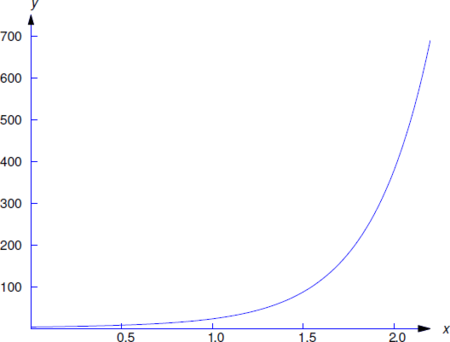7.2: Higher Order Homogeneous Equations
- Page ID
- 103557
Higher Order Constant Coefficient Homogeneous Equations
If \(a_0\), \(a_1\), …, \(a_n\) are constants and \(a_0\ne0\), then
\[a_0y^{(n)}+a_1y^{(n-1)}+\cdots+a_ny=F(x)\nonumber \]
is said to be a constant coefficient equation. In this section we consider the homogeneous constant coefficient equation
\[\label{eq:9.2.1} a_0y^{(n)}+a_1y^{(n-1)}+\cdots+a_ny=0.\]
The theorems in Section 7.1 all apply with \((a,b)=(-\infty,\infty)\).
As in Section 5.3 we use \(y=e^{rx}\) as our solution and from substituting repeated derivatives into \ref{eq:9.2.1} we get the characteristic equation
\[\label{eq:9.2.2} a_0r^n+a_1r^{n-1}+\cdots+a_n=0\]
We saw in Section 5.3 that when \(n=2\) the solutions of Equation \ref{eq:9.2.1} are determined by the solutions of the characteristic equation. This is also true when \(n>2\).
The discussion we had in 5.3 regarding distinct, repeating, and complex roots is valid here as well. Additionally, distinct roots always lead to independent solutions, repeated roots multiply the repeated solution by \(x\) each time a root is repeated, thereby leading to independent solutions, and repeated complex roots are handled the same way as repeated real roots. We will illustrate each idea in the following examples.
- Find the general solution of \[\label{eq:9.2.3} y'''-6y''+11y'-6y=0.\]
- Solve the initial value problem \[\label{eq:9.2.4} y'''-6y''+11y'-6y=0, \quad y(0)=4,\quad y'(0)=5,\quad y''(0)=9.\]
Solution a
The characteristic equation of Equation \ref{eq:9.2.3} is
\[r^3-6r^2+11r-6=(r-1)(r-2)(r-3)=0. \nonumber\]
Therefore \(\{e^x,e^{2x},e^{3x}\}\) is a fundamental set of solutions of Equation \ref{eq:9.2.3} and the general solution of Equation \ref{eq:9.2.3} is
\[\label{eq:9.2.5} y=c_1e^{x}+c_2e^{2x}+c_3e^{3x}.\]
Solution b
We must determine \(c_1\), \(c_2\) and \(c_3\) in Equation \ref{eq:9.2.5} so that \(y\) satisfies the initial conditions in Equation \ref{eq:9.2.4}. Differentiating Equation \ref{eq:9.2.5} twice yields
\[\label{eq:9.2.6} \begin{array}{rcl} y'&=&c_1e^{x}+2c_2e^{2x}+3c_3e^{3x}\\ y''&=&c_1e^{x}+4c_2e^{2x}+9c_3e^{3x}. \end{array}\]
Setting \(x=0\) in Equation \ref{eq:9.2.5} and Equation \ref{eq:9.2.6} and imposing the initial conditions yields
\[\begin{array}{rcl} c_1+\phantom{2}c_2+\phantom{3}c_3&=&4\\ c_1+2c_2+3c_3&=&5\\ c_1+4c_2+9c_3&=&9. \end{array}\nonumber \]
The solution of this system is \(c_1=4\), \(c_2=-1\), \(c_3=1\). Therefore the solution of Equation \ref{eq:9.2.4} is
\[y=4e^x-e^{2x}+e^{3x} \nonumber\]
(Figure 7.2.1 ).

Find the general solution of
\[\label{eq:9.2.7} y'''+3y''+3y'+y=0.\]
Solution
The characteristic equation of Equation \ref{eq:9.2.7} is
\[r^3+3r^2+3r+1=(r+1)^3=0. \nonumber\]
Therefore \(\{e^{-x},xe^{-x},x^2e^{-x}\}\) is a fundamental set of solutions of Equation \ref{eq:9.2.7} and the general solution of Equation \ref{eq:9.2.7} is
\[y=e^{-x}(c_1+c_2x+c_3x^2). \nonumber\]
Find the general solution of
\[\label{eq:9.2.8} y'''-y''+y'-y=0.\]
Solution
The characteristic equation of Equation \ref{eq:9.2.8} is
\[r^3-r^2+r-1=(r-1)(r^2+1)=0. \nonumber\]
Therefore \(\{e^{x},\cos x,\sin x\}\) is a fundamental set of solutions of Equation \ref{eq:9.2.8} and the general solution of Equation \ref{eq:9.2.8} is \[y=c_1e^x+c_2\cos x+c_3\sin x\].
To help with the notation when we use annihilation we will often use differential operator notation, as the following examples illustrate.
Find the general solution of
\[\label{eq:9.2.9} y^{(4)}-16y=0.\]
Solution
The characteristic equation of Equation \ref{eq:9.2.9} is
\[\begin{align*} r^4-16=(r^2-4)(r^2+4)=(r-2)(r+2)(r^2+4)=0. \end{align*}\nonumber \]
Using differential operator notation, Equation \ref{eq:9.2.9} can be written as
\[(D^4-16)y=0 \nonumber\]
or
\[(D^2-4)(D^2+4)y=0 \nonumber\]
or
\[(D-2)(D+2)(D^2+4)y=0. \nonumber\]
Note that the differential equation written in differential operator notation mirrors the characteristic equation, and we can see the solutions from either.
Hence, \(\{e^{2x},e^{-2x},\cos2x,\sin2x\}\) is a fundamental set of solutions of Equation \ref{eq:9.2.9} and
\[y_1=c_1e^{2x}+c_2e^{-2x}+c_3\cos2x+c_4\sin2x \nonumber\]
is the general solution of Equation \ref{eq:9.2.9}.
Find the general solution of
\[\label{eq:9.2.19} (D^2+4D+13)^3y=0.\]
Solution
The characteristic equation of Equation \ref{eq:9.2.19} is
\[(r^2+4r+13)^3=\left((r+2)^2+9\right)^3=0. \nonumber\]
Therefore Equation \ref{eq:9.2.19} can be be written as
\[[(D+2)^2+9]^3y=0. \nonumber\]
The roots are \(r=-2 \pm 3i,-2 \pm 3i,-2 \pm 3i\)
The general solution of Equation \ref{eq:9.2.19} is
\[y=(a_1+a_2x+a_3x^2)e^{-2x}\cos3x +(b_1+b_2x+b_3x^2)e^{-2x}\sin3x. \nonumber\]
Find the general solution of
\[\label{eq:9.2.20} y^{(4)}+4y'''+6y''+4y'=0.\]
Solution
The characteristic equation of Equation \ref{eq:9.2.20} is
\[\begin{aligned} r^4+4r^3+6r^2+4r=r(r^3+4r^2+6r+4)=r(r+2)(r^2+2r+2)=r(r+2)[(r+1)^2+1]=0.\end{aligned}\nonumber \]
Therefore Equation \ref{eq:9.2.20} can be written as
\[[(D+1)^2+1](D+2)Dy=0. \nonumber\]
Therefore the general solution of Equation \ref{eq:9.2.20} is
\[y=e^{-x}(c_1\cos x+c_2\sin x)+c_3e^{-2x}+c_4. \nonumber\]
Find the general solution of
\[\label{eq:9.2.21} [(D+1)^2+1]^2(D-1)^3(D+1)D^2y=0.\]
Solution
At this point you should be able to identify the roots immediately as \[r=-1 \pm i,-1 \pm i, 1,1,1,-1,0,0.\nonumber\]
The general solution of Equation \ref{eq:9.2.21} is therefore
\[y=c_1e^{-x} \cos x+c_2e^{-x} \sin x+c_3x e^{-x} \cos x+c_4x e^{-x} \sin x+c_5e^x+c_6xe^x+c_7x^2e^x+c_8e^{-x}+c_9+c_{10}x.\nonumber\]
Higher Order Cauchy-Euler Equations
If \(a_0\), \(a_1\), …, \(a_n\) are constants and \(a_0\ne0\), then
\[a_0x^ny^{(n)}+a_1x^{n-1}y^{(n-1)}+\cdots+a_{n-1}xy'+a_ny=F(x)\nonumber \]
is said to be a Cauchy-Euler equation. In this section we consider the homogeneous Cauchy-Euler Equation
\[\label{eq:9.2.22} a_0x^ny^{(n)}+a_1x^{n-1}y^{(n-1)}+\cdots+a_{n-1}xy'+a_ny=0.\]
The theorems in Section 7.1 all apply with \((a,b)\)=\((-\infty,0)\) and \((0,\infty)\).
As in Section 5.7 we use \(y=x^r\) as our solution and from substituting repeated derivatives into \ref{eq:9.2.22} we get the characteristic equation
\[\label{eq:9.2.23} a_0r(r-1)\cdots(r-(n-1))+a_1r(r-1)\cdots(r-(n-2))+\cdots+a_{n-1}r+a_n=0\]
We saw in Section 5.7 that when \(n=2\) the solutions of Equation \ref{eq:9.2.22} are determined by the solutions of the characteristic equation. This is also true when \(n>2\).
The discussion we had in 5.7 regarding distinct, repeating, and complex roots is valid here as well. Additionally, distinct roots always lead to independent solutions, repeated roots multiply the repeated solution by \(\ln x\) each time a root is repeated, thereby leading to independent solutions, and repeated complex roots are handled the same way as repeated real roots. We will illustrate each idea in the following examples.
Find the general solution of \[\label{eq:9.2.24} x^3y'''-3x^2y''+6xy'-6y=0\]
on \((0,\infty)\).
Solution
The characteristic equation of Equation \ref{eq:9.2.24} is
\[r(r-1)(r-2)-3r(r-1)+6r-6=(r-1)(r-2)(r-3)=0. \nonumber\]
Therefore \(\{x,x^2,x^3\}\) is a fundamental set of solutions of Equation \ref{eq:9.2.24} and the general solution of Equation \ref{eq:9.2.24} is
\[y=c_1x+c_2x^2,+c_3x^3.\nonumber\]
Find the general solution of \[\label{eq:9.2.25} x^3y'''+xy'-y=0\]
on \((0,\infty)\).
Solution
The characteristic equation of Equation \ref{eq:9.2.25} is
\[r(r-1)(r-2)+r-1=(r-1)^3=0. \nonumber\]
Therefore \(\{x,x\ln x,x\ln^2 x\}\) is a fundamental set of solutions of Equation \ref{eq:9.2.25} and the general solution of Equation \ref{eq:9.2.25} is
\[y=c_1x+c_2x\ln x,+c_3x\ln^2 x.\nonumber\]
Find the general solution of \[\label{eq:9.2.26} x^3y'''+5x^2y''+7xy'+8y=0\]
on \((0,\infty)\).
Solution
The characteristic equation of Equation \ref{eq:9.2.26} is
\[r(r-1)(r-2)+5r(r-1)+7r+8=(r+2)(r^2+4)=0. \nonumber\]
Therefore \(\{x^{-2},\cos (2\ln x),\sin (2\ln x)\}\) is a fundamental set of solutions of Equation \ref{eq:9.2.26} and the general solution of Equation \ref{eq:9.2.26} is
\[y=c_1x^{-2}+c_2\cos (2\ln x)+c_3\sin (2\ln x).\nonumber\]
Find the general solution of a tenth order Cauchy-Euler Equation that has the following roots for its characteristic equation:
\[r=-3 \pm 5i,-3 \pm 5i,-3 \pm 5i,3,0,0,0.\nonumber\]
Solution
\[y=c_1x^{-3}\cos (5\ln x)+c_2x^{-3}\sin (5\ln x)+c_3x^{-3}\cos (5\ln x)\ln x+c_4x^{-3}\sin (5\ln x)\ln x+c_5x^{-3}\cos (5\ln x)\ln^2x+c_6x^{-3}\sin (5\ln x)\ln^2x+c_7x^3+c_8+c_9\ln x+c_{10}\ln^2x\nonumber\]


